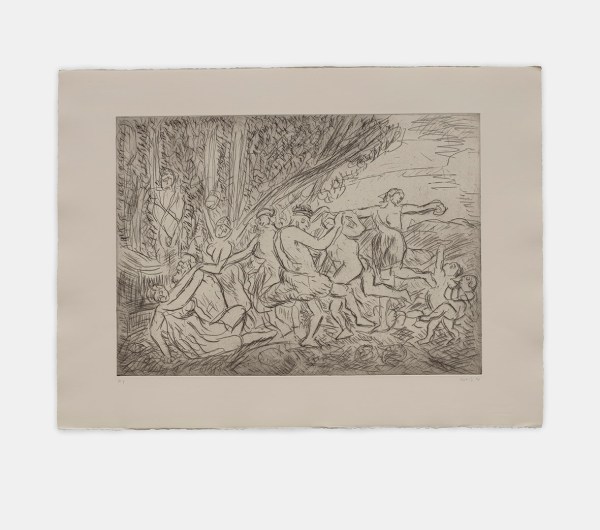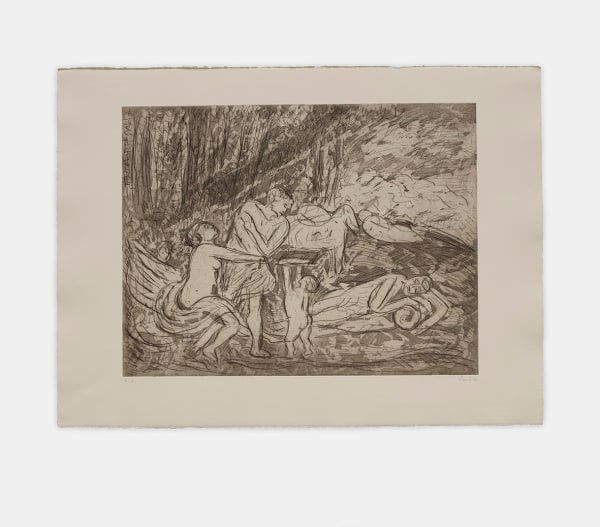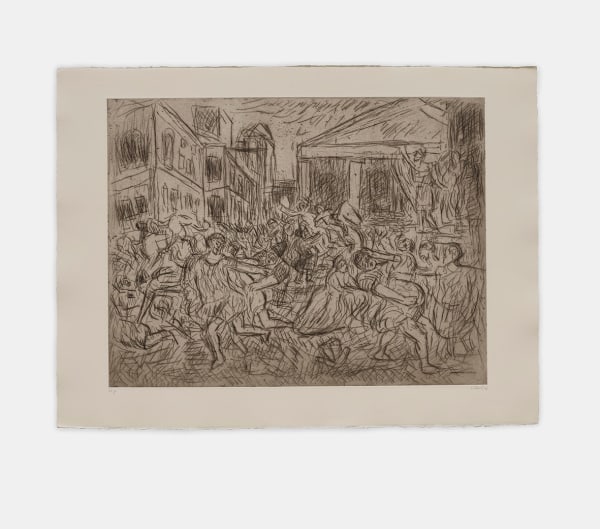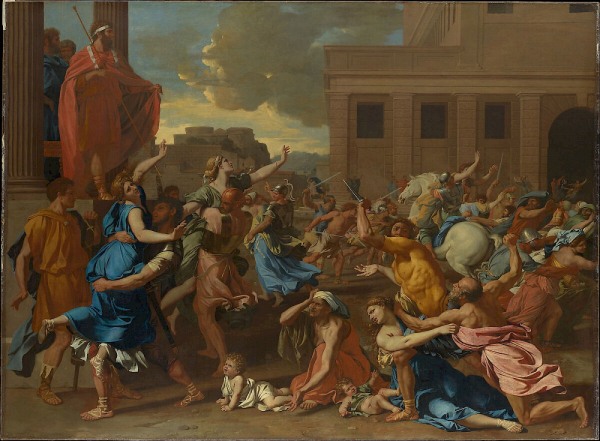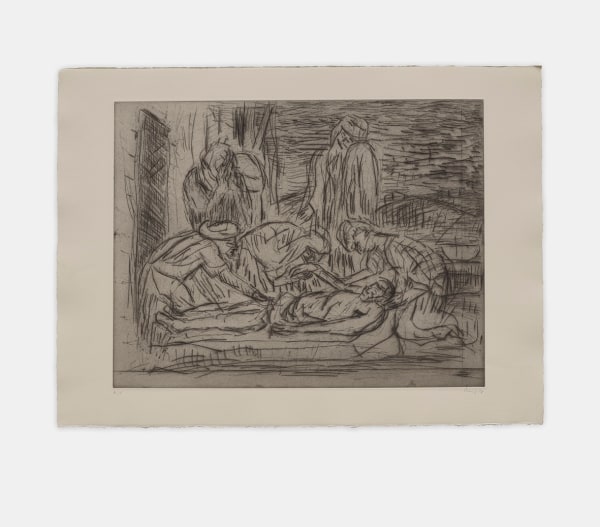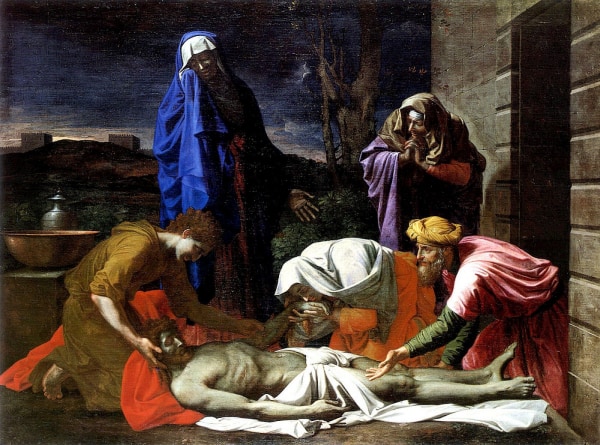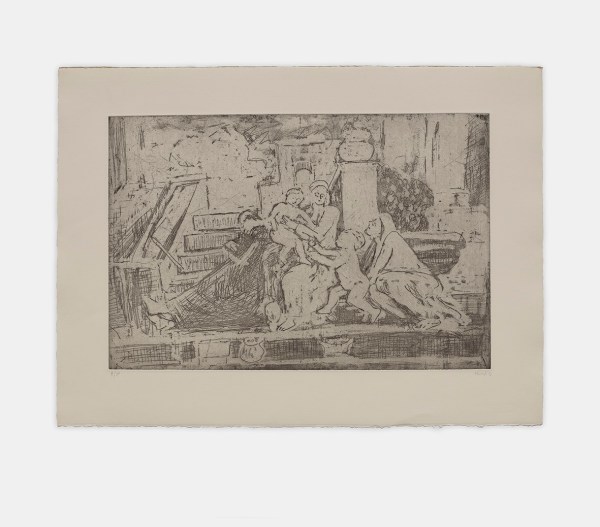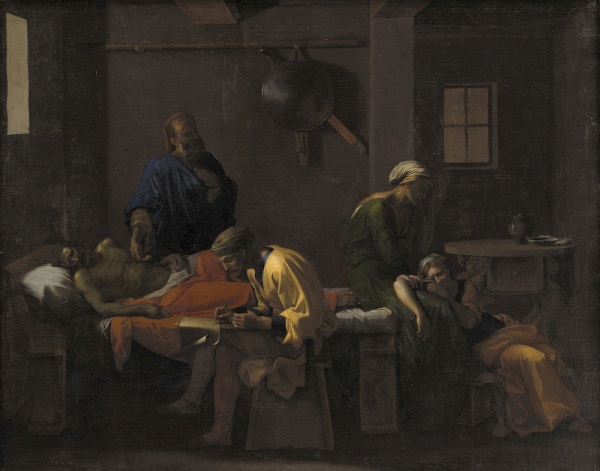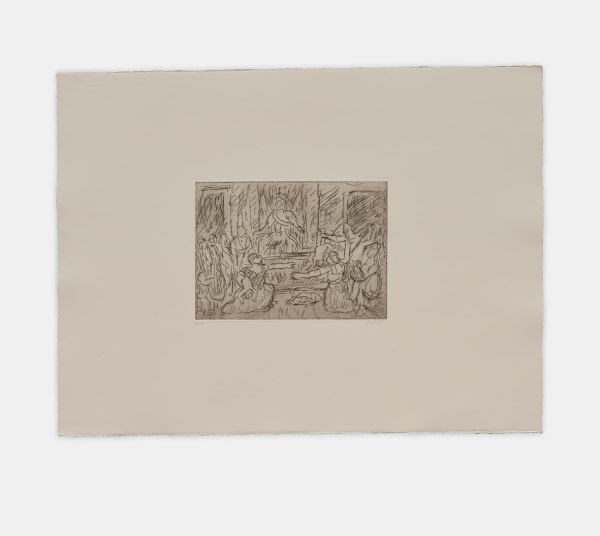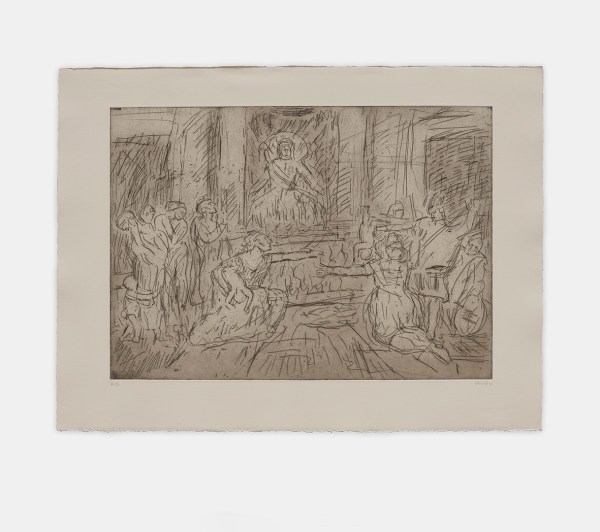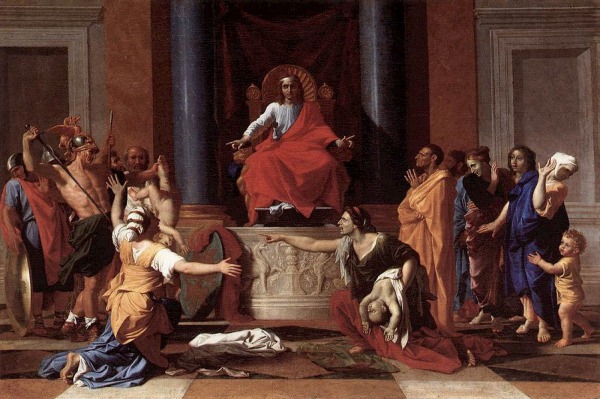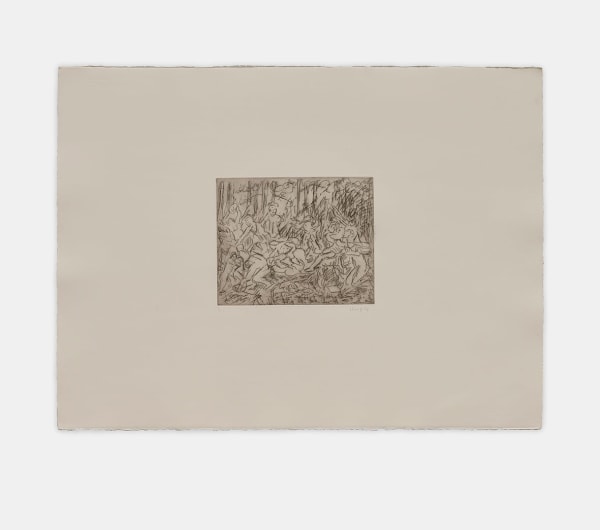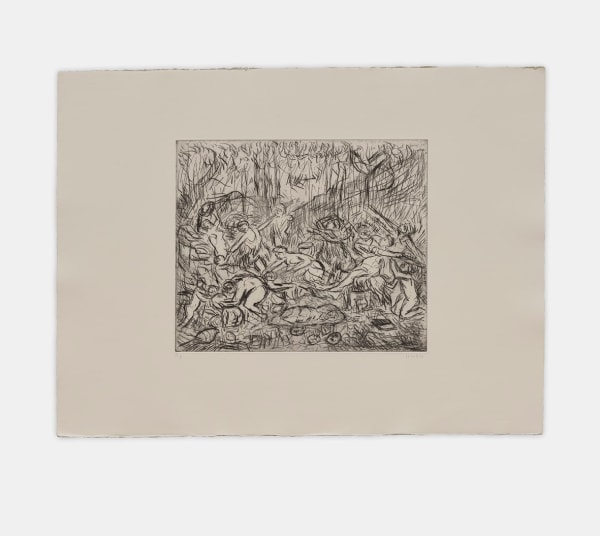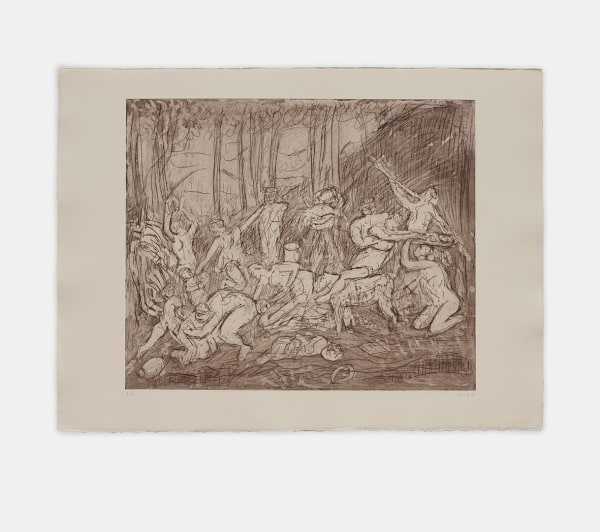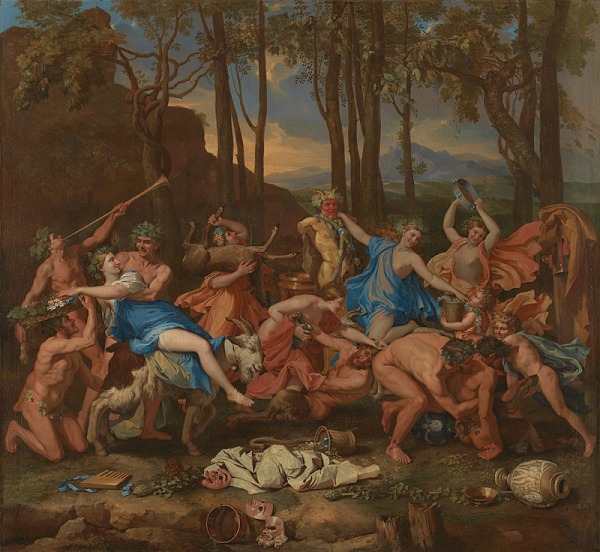-
Leon Kossoff: After Poussin
Leon Kossoff is best known as an artist of London. His paintings of Kilburn, Dalston or Christ Church Spitalfields, with their churned and agitated surfaces, are instantly recognizable. Aside from London, his other great passion was the art of the past - or rather, paintings by certain artists of the past. Rubens, Veronese, Constable and Rembrandt were numbered amongst them, with their generous and expressive paint handling perhaps helping to explain why he felt such a deep attraction to them. However, this does not apply to another of Kossoff’s artist heroes, the seventeenth-century Frenchman, Nicolas Poussin, whose pictures are carefully executed with an apparently emotionless detachment.
Poussin is often cited as the intellectual painter par excellence and his work is discussed in terms of his measured draughtsmanship and rigorously thought-out compositions. Kossoff ignores such an interpretation. For him, Poussin is a painter of passion who communicates as much humanity and warmth as anyone else you care to name. From 1976 onwards he made several painted and drawn responses to compositions by Poussin in the National Gallery, as well as a whole host of prints. And following his many visits to the great Poussin exhibition held at the Royal Academy in 1995, he turned again to printmaking to investigate his love for Poussin even further.
For Kossoff, printmaking was a medium of exploration and experiment. Crucial to these prints was the experience of working directly in front of the original paintings. The National Gallery had given him out-of-hours access to draw from its collection and the Royal Academy offered him a similar opportunity for its Poussin exhibition. He liked to start at 7am, drawing with his etching needle straight into the prepared grounds of his plates. Back in the studio, these plates would be bitten with acid, cleaned and printed. They would then be prepared with an aquatint ground onto which Kossoff could work with the liquid stop-out varnish, to produce the various tones. Often, the final part of the process was for the artist to add drypoint lines, gouging directly into the copper plates with a sharp steel tool to strengthen the emphasis in certain areas.
These prints should not be seen simply as a contemporary artist’s modern versions of Poussin’s paintings. For Kossoff, each new encounter with a favourite work was like seeing it for the first time, trying to discover what it was that made him love these pictures so much. ‘The more I work from them, the more mysterious they become’ he would often say. His heartfelt response enabled him to make an imaginative leap into the world that Poussin had created, as if witnessing at first hand the Biblical and mythological dramas or those exuberant pagan dances.
These prints are packed with energy, light and life. They exist as independent works yet they also send us back to Poussin, allowing us to experience his genius through the eyes of one of the most significant and original artists of our time. -
Cephalus and Aurora
Based on Nicolas Poussin's painting of Cephalus and Aurora (c.1630), this scene tells the vengeful story of Cephalus and Aurora described in Ovid's Metamorphoses. Diana, goddess of hunting, gave the hunter Cephalus a magic dog and spear. Later Aurora, the goddess of dawn, fell in love with the mortal Cephalus and tried to seduce him. In his struggle, he mistook the noise of his wife hiding in the woods for that of a wild animal and threw his spear, killing her. Kossoff and Poussin’s scenes show Aurora clinging to Cephalus as he attempts to flee. Unlike the original painting, Kossoff delineates the background with harsh black strokes to create a sense of frenzied movement that echoes the pair’s desperation.
-
Cephalus and Aurora No. 2 is a highly finished version of the Cephalus and Aurora etching. Kossoff used black lines and dappled shadows in the background to create a stark monochromatic difference between the pale, unshaded figures and the landscape. He achieved this effect through partial stopping out, where the artist covers the varnish to arrest the action of the acid in the etching. The artist then incised the etching with drypoint, darkening the black background further.
-
-
 Leon KossoffCephalus and Aurora No. 11998AP from an Edition of 20, plus 10 APEtchingSheet 22 1/2 x 29 1/2 in. / 57.3 x 74.9 cm
Leon KossoffCephalus and Aurora No. 11998AP from an Edition of 20, plus 10 APEtchingSheet 22 1/2 x 29 1/2 in. / 57.3 x 74.9 cm
Plate 18 x 21 1/2 in. / 45.6 x 54.6 cm -
 Leon KossoffCephalus and Aurora No. 2 1998AP from an Edition of 20, plus 10 APEtching and aquatintSheet 22 1/2 x 29 7/8 in/ 57.1 x 76 cm
Leon KossoffCephalus and Aurora No. 2 1998AP from an Edition of 20, plus 10 APEtching and aquatintSheet 22 1/2 x 29 7/8 in/ 57.1 x 76 cm
Plate 16 7/8 x 21 7/8 in. / 42.9 x 55.7 cm
-
-
Bacchanal before a Herm
Bacchanal Before a Herm shows a cult of Arcadian revellers drinking and dancing in a bacchanal for the ancient god Pan, or Priapus, traditionally associated with fertility rites and drunkenness. As in the original Nicolas Poussin painting, Pan is represented both by the lead dancer in the centre, who wears a subtle flower crown, and the marble statue visible in a nearby thicket. Kossoff mimics the monumentality of Poussin’s muscular figures, creating movement in the etched trees which seem to sway around the dancers. Another version of this etching is in the permanent collection of The Metropolitan Museum of Art, New York.
-
The Rape of Sabines
Modelled on Poussin’s The Rape of Sabine Women (1634), now held in The Metropolitan Museum of Art, New York, this etching compresses a violent episode from the early history of ancient Rome. According to Roman mythology, the neighbouring Sabines were invited to a festival before the Roman soldiers forcibly seized the women as wives. The above version is among the most painterly of Kossoff’s etchings, with a rhythmic line and modulated tone.
The mythological scene was a popular subject in post-Renaissance painting. To Kossoff, who had served in the Jewish Infantry Brigade across Europe in WWII, it may have also recalled the atrocities and scorched-earth policies of the invading armies in World War II. -
-
 Leon KossoffThe Rape of Sabines No. 11998AP from an Edition of 20, plus 10 APEtchingSheet 22 1/2 x 29 7/8 in. / 57.2 x 75.9 cm
Leon KossoffThe Rape of Sabines No. 11998AP from an Edition of 20, plus 10 APEtchingSheet 22 1/2 x 29 7/8 in. / 57.2 x 75.9 cm
Plate 17 7/8 x 23 3/8 in. / 45.4 x 59.4 cm -
 Leon KossoffThe Rape of the Sabines No. 21998AP from an Edition of 20, plus 10 APEtchingSheet 22 1/2 x 29 7/8 in. / 57.3 x 75.9 cm
Leon KossoffThe Rape of the Sabines No. 21998AP from an Edition of 20, plus 10 APEtchingSheet 22 1/2 x 29 7/8 in. / 57.3 x 75.9 cm
Plate 16 7/8 x 22 3/4 in. / 42.9 x 57.9 cm
-
-

-
The Lamentation over Dead Christ
This reinterpretation of Poussin’s The Lamentation of the Dead Christ (1957) portrays the Virgin Mary weeping over the body of Jesus with a group of mourners in a temple. In Kossoff’s sparse, relief-like version, the mourners show their devotion by mirroring Christ’s prone body on the stone floor, as if they were literally bent over by suffering.
-
The Holy family on the Steps
Based on Poussin’s The Holy Family on the Steps (1948), this etching depicts the Holy Family with Saint Elizabeth and Saint John the Baptist in a scene of classical architecture. The figures’ simple pyramid shape evokes order and tranquillity, which Kossoff emphasized by alternating white spaces with densely cross-hatched elements, such as the steps in the foreground with the figures.
-

-
The Testament of Eudamidas
The subject of the painting is taken from the ancient Greek writer Lucian’s Toxaris (friendship), a classic story of stoicism and true friendship. On his deathbed the poor but noble Eudamidas leaves the care of his mother and daughter in the hands of his two closest friends, who accept the responsibility without protest.
Poussin’s painting is an unusually dark, contemplative image for the artist, reflecting the seriousness of the moral tale. Kossoff has carved out space around the figure by cross-hatching drypoint, creating an atmosphere of sorrow around the dying man. This unassuming etching defines the drama of the original composition in simple, sympathetic lines. -
The Judgement of Solomon
This series depicts the biblical story of The Judgement of Solomon, in which King Solomon ruled between two women who both claimed to be the mother of a child. Solomon declared his judgement that the baby would be cut in half. One mother did not contest the ruling, declaring that if she could not have the baby no one could. The other, who begged Solomon to give the baby to the other woman, was declared the true mother for her desire to preserve the baby’s life. Diagonal lines emphasize the central figure of Solomon in this close-up view of the court chamber. Kossoff carefully inked the plate to enhance the illusion of three-dimensional space space.
-
-
 Leon KossoffThe Judgement of Solomon No. 11998AP from an Edition of 20, plus 10 APEtchingSheet 22 1/2 x 29 7/8 in. / 57.3 x 75.9 cm
Leon KossoffThe Judgement of Solomon No. 11998AP from an Edition of 20, plus 10 APEtchingSheet 22 1/2 x 29 7/8 in. / 57.3 x 75.9 cm
Plate 8 1/2 x 11 3/4 in. / 21.6 x 29.8 cm -
 Leon KossoffThe Judgement of Solomon No. 21998AP from an Edition of 20, plus 10 APEtchingSheet 22 1/2 x 29 7/8 in. / 57.3 x 75.9 cm
Leon KossoffThe Judgement of Solomon No. 21998AP from an Edition of 20, plus 10 APEtchingSheet 22 1/2 x 29 7/8 in. / 57.3 x 75.9 cm
Plate 16 3/4 x 23 3/8 in. / 42.5 x 59.5 cm
-
-
This larger version of the two prints takes a longer view of the chamber where the event occurs. Kossoff stresses attention to each individual figure, seen in the clear depiction of Solomon’s face. The scratches on the plate, paired with the loosely applied passages of tone, are all integrated into the final image and allow for the three-dimensionality of the space to come through.
-
The Triumph of Pan
This etching series depicts an ancient mythological scene of men, women, children, and satyrs in a triumphant embrace as they celebrate the horned deity Pan over a profusion of food, drink and flowers. Kossoff creates a minimal and stripped-back version of Poussin's painting by cutting out the landscape and surrounding detail of the painting. This abstracted version of the scene focuses on human themes. Dancing figures merge with the earth and rocks that surround them, stressing a mass of writhing bodies that suggests the danger and thrill of a hysterical crowd.
-
-
 Leon KossoffThe Triumph of Pan No. 11998AP from an Edition of 20, plus 10 APEtchingSheet 22 1/2 x 29 7/8 in. / 57.3 x 75.9 cm
Leon KossoffThe Triumph of Pan No. 11998AP from an Edition of 20, plus 10 APEtchingSheet 22 1/2 x 29 7/8 in. / 57.3 x 75.9 cm
Plate 7 7/8 x 9 5/8 in. / 20 x 24.4 cm -
 Leon KossoffThe Triumph of Pan No. 21998AP from an Edition of 20, plus 10 APEtchingSheet 22 1/2 x 29 3/4 in. / 57 x 75.7 cm
Leon KossoffThe Triumph of Pan No. 21998AP from an Edition of 20, plus 10 APEtchingSheet 22 1/2 x 29 3/4 in. / 57 x 75.7 cm
Plate 13 x 15 1/2 in. / 33 x 39.4 cm
-
-
The heavy outlining of the figures in The Triumph of Pan No. 2 and the intense cross-hatching against the pale, curved bodies of the revellers allow them to stand out from the composition. The frenzy of cross-hatching consists of vertical and diagonal lines, which create movement and dynamism in the print.
-
-
 Leon KossoffThe Triumph of Pan No. 31998AP from an Edition of 20, plus 10 APEtchingSheet 22 1/2 x 29 3/4 in. / 57.1 x 75.7 cm
Leon KossoffThe Triumph of Pan No. 31998AP from an Edition of 20, plus 10 APEtchingSheet 22 1/2 x 29 3/4 in. / 57.1 x 75.7 cm
Plate 18 x 21 1/2 in. / 45.6 x 54.6 cm -
 Leon KossoffThe Triumph of Pan No. 41998AP from an Edition of 20, plus 10 APEtchingSheet 22 1/2 x 29 7/8 in. / 57.3 x 75.9 cm
Leon KossoffThe Triumph of Pan No. 41998AP from an Edition of 20, plus 10 APEtchingSheet 22 1/2 x 29 7/8 in. / 57.3 x 75.9 cm
Plate 18 x 21 3/8 in. / 45.6 x 54.2 cm
-
-
Human bodies writhe over a dark landscape in The Triumph of Pan No. 3, which has a more formal and static feel than its counterparts. Kossoff used a tonal wash horizontal across the print to darken the surrounding landscape. He then partially wiped it clean to highlight the dancing figures, as if we were looking through a dirty window that has been coarsely wiped to show the revelling crowd.
-
‘It seemed as though I was experiencing the work for the first time,’ Kossoff wrote of the transformative experience of looking at Poussin’s work at the National Gallery of London as a student – the moment that sparked his fascination. ‘I suppose there is a difference between looking and experiencing. Paintings of this quality, in which the subject is endlessly glowing with luminosity, can, in an unexpected moment, surprise the viewer, revealing unexplored areas of self.'*
*Richard Kendall, Drawn to Painting, London 2000, p.19
